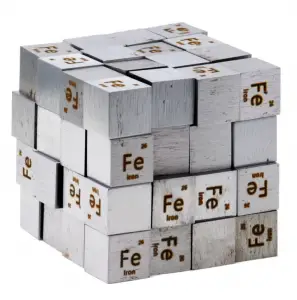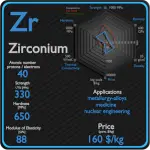This article contains comparison of key thermal and atomic properties of oxygen and iron, two comparable chemical elements from the periodic table. It also contains basic descriptions and applications of both elements. Oxygen vs Iron.

Oxygen and Iron – About Elements


Source: www.luciteria.com
Oxygen and Iron – Applications
Oxygen
Common uses of oxygen include production of steel, plastics and textiles, brazing, welding and cutting of steels and other metals, rocket propellant, oxygen therapy, and life support systems in aircraft, submarines, spaceflight and diving. Smelting of iron ore into steel consumes 55% of commercially produced oxygen. In this process, oxygen is injected through a high-pressure lance into molten iron, which removes sulfur impurities and excess carbon as the respective oxides, sulfur dioxide and carbon dioxide. Uptake of oxygen from the air is the essential purpose of respiration, so oxygen supplementation is used in medicine. Treatment not only increases oxygen levels in the patient’s blood, but has the secondary effect of decreasing resistance to blood flow in many types of diseased lungs, easing work load on the heart.
Iron
Iron is used in numerous sectors such as electronics, manufacturing, automotive, and construction and building. Iron is the most widely used of all the metals, accounting for over 90% of worldwide metal produc0tion. Its low cost and high strength often make it the material of choice material to withstand stress or transmit forces, such as the construction of machinery and machine tools, rails, automobiles, ship hulls, concrete reinforcing bars, and the load-carrying framework of buildings. Since pure iron is quite soft, it is most commonly combined with alloying elements to make steel. Steels are iron–carbon alloys that may contain appreciable concentrations of other alloying elements. Adding a small amount of non-metallic carbon to iron trades its great ductility for the greater strength. Due to its very-high strength, but still substantial toughness, and its ability to be greatly altered by heat treatment, steel is one of the most useful and common ferrous alloy in modern use. There are thousands of alloys that have different compositions and/or heat treatments. The mechanical properties are sensitive to the content of carbon, which is normally less than 1.0 wt%.
Oxygen and Iron – Comparison in Table
| Element | Oxygen | Iron |
| Density | 0.00125 g/cm3 | 7.874 g/cm3 |
| Ultimate Tensile Strength | N/A | 540 MPa |
| Yield Strength | N/A | 50 MPa |
| Young’s Modulus of Elasticity | N/A | 211 GPa |
| Mohs Scale | N/A | 4.5 |
| Brinell Hardness | N/A | 490 MPa |
| Vickers Hardness | N/A | 608 MPa |
| Melting Point | -209.9 °C | 1538 °C |
| Boiling Point | -195.8 °C | 2861 °C |
| Thermal Conductivity | 0.02598 W/mK | 80.2 W/mK |
| Thermal Expansion Coefficient | N/A | 11.8 µm/mK |
| Specific Heat | 1.04 J/g K | 0.44 J/g K |
| Heat of Fusion | (N2) 0.7204 kJ/mol | 13.8 kJ/mol |
| Heat of Vaporization | (N2) 5.56 kJ/mol | 349.6 kJ/mol |























